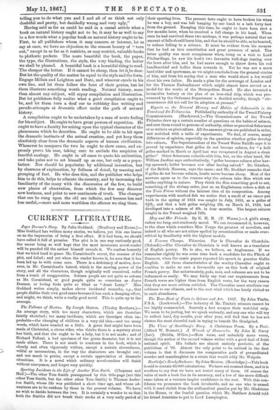Reports on the Natural History and Habits of Salmonoids in
the Tweed and Its Tributaries. Published by authority of the Tweed Fishery
Commissioners. (Blackwood.)—The Commissioners of the Tweed Fisheries drew up a certain number of questions on the habits of salmon, and sent them round to persons of authority, either as practical fishermen or as writers on pisciculture. All the answers given are published in order, and enriched with a table of experiments. We find, of course, many differences of opinion, especially on the question whether grilse develop into salmon. The Superintendent of the Tweed Water Bailiffs says it is proved by experience that grilse do not become salmon, for "a kelt grilse marked in March or April last was recaptured in August a clean grilse." Other fishermen coincide with him, but, on the other hand, Sir
William Jardine says authoritatively, "grilse becomes salmon after hav- ing spawned; heifer becomes cow after having calved." Dr. Giinther, of the British Museum, says the same ; and Mr. Stoddart remarks that
if grilse do not become salmon, lambs never become sheep. Most of the answers agree as to the reasons why the salmon take flies which are unlike anything in nature. They think the flies something good to eat,
something of the shrimp order, just as an Englishman orders a dish at the Trois Freres without the faintest idea of its composition. Among
experiments with marked fish we notice that a smolt of an ounce put back in the spring of 1854 was caught in July, 1855, as a grilse of 3i4b., and that a kelt grilse weighing 21b. on March 31, 1858, had developed into a salmon of 81b. in four months. The largest salmon caught in the Tweed weighed 721b.






























 Previous page
Previous page